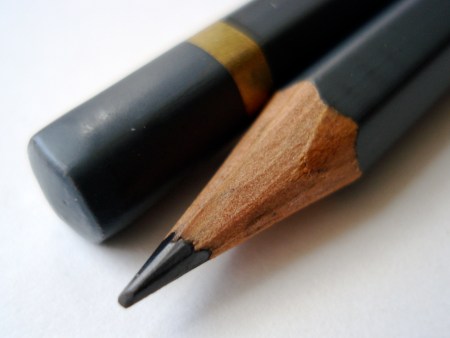
The Conté à Paris Graphite 601 pencil is a great find, as well as a rarity, being possibly the only woodcase pencil currently manufactured in France.
I was very pleased to discover that a small local bookstore had tins of these pencils on their modest art supply shelf.
The pencils come in a range of degrees from 3H through 6B, and are finished in a serious grey with gold lettering.
They are truly first rate – very rich and smooth, leaving dense, saturated lines. If better known, they could potentially be market leaders.
Now about the names – I thank the Paris office of ColArt, and blog reader Frank, for research assistance with the following.
Conté is named after balloonist, military officer, and chemist Nicolas-Jacques Conté, creator of the graphite-clay manufacturing process which is still used today, freeing manufacturers from the need to procure intact whole graphite pieces – which in the Napoleonic era, would only have been available from the Borrowdale mine of then-adversary England.
Akin to Newton and Leibniz, Conté’s contemporary Hardmuth was making similar breakthroughs in this era.
I’m not an art supplies historian, but Conté is also cited for advances in manufacturing sanguine and sepia pastels, based on pigments first used in the Italian renaissance – and still today.
Conté received French patent No. 32 and formed la Société Conté to manufacture his creations.
The company (at least in name) seems to have survived almost two centuries, and was purchased in 1979 by Bic.
So what are all the various pencils we’ve seen, and what is this one?
The answer found in Bic financial statements is that they sold the trademark “Conté à Paris” to ColArt for 1.5 million Euros in 2004. The “Ballograf” brand was also sold as part of the same “return to core products” initiative. Essentially, Conté was seen as a focused high end brand, not aligned with Bic’s mass market strategy.
So wait a minute – “Conté”, “Conté à Paris”, what’s going on and what is the difference? Well the financial statements mention “Conté à Paris”, which is the name on ColArt branded products – pencils and otherwise. Bic has moved former “Conté” products to the “BIC Kids” line, while still selling older stock under the name.
So the agreement appears to involve a transition – ColArt uses and will use “Conté à Paris” for high-end fine arts products, and Bic retains rights to use “Conté” while it transitions to “BIC Kids” – school/children’s supplies.
So who is ColArt? Rest assured, they aren’t a name most of us would know – but they are the owner of leading artist brands “Winsor & Newton”, “Liquitex”, and many others. ColArt is in turn part of a Swedish conglomerate – but that’s as far as we’ll go investigating corporate lineage here.
The logos, particularly the rendering of “Conté”, are the same in both brands – no doubt by agreement.
Congratulations to ColArt for carrying on a tradition of excellence.
Further reading: Conté memorial.

I was thinking Rhodia pencils were made in France. Now I wonder where they come from?
Conte, and sharpened with a knife no less! I try to send emails and photos to editor@penciltalk.org, but with no luck……why?
Lucky find and quite thorough research! One never knows what treasures might await in small local bookstores. Pity they seem to be disappearing with the prevalence of the giant bookstores through much of the USA.
Diane, I forgot about those pencils, which I did look at in 2006. If they were made in France, I’m pretty sure they would state so. (And I think the dyed basswood triangular shape is a super-specialty.)
Saumiq, you’ve tried to send me mail? Did it bounce back? There is no shortage of incoming mail here, so I think the mail server is functioning.
Alberto, yes, I’m glad that there are a few bookstores which stock some other items such as blank books and writing implements.
This retailer says they’re made in France, but I can’t find anything to confirm that. There are no markings other than the Rhodia logo and a bar code on the box.
http://notemaker.com.au/products/rhodia-pencils
I looked up linden wood and basswood on Wikipedia for fun, and in the linden entry, there’s no mention of pencils as a use. Some expert needs to remedy that!
One other thing—Don from PencilThings mentioned the Rhodias shipped from France, although I know that doesn’t mean anything.
Diane, I’ll try asking Rhodia about this question.
Reading this thread I found very interesting to give a try to this pencils, and living in Catalonia, that is, near France, I made some research in local book-store and I found some 2B Graphitte 601. They really are very good pencils at same quality as my Lumographs, FC9000, or cretacolor cleos. I have to find some Caran D’ache Technograph 777 to round my own ranking in the 2B ligue.
Thanks to let me know these.
I have 3 of these in my collection (Round Barrel). The ‘H’ is not a true ‘H’ – too dark and lead core not centred. The ‘B’ is smooth but not in a waxy way, a very dry, crisp smooth and very loud and hollow sounding on the paper. Loses point very quickly but does sharpen exceptionally well in one long spiral. Same comments as ‘B’ but not as loud. Compared to a Faber-Castell 9000 3B – not quite as smooth but certainly high class. Well worth having in the collection but at AD4.55 (US4.70) per pencil in a Sydney Art Store, they will never become “users”.
…humm, should have said, The 3B – same comments as ‘B’…